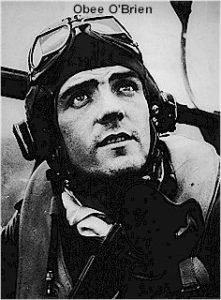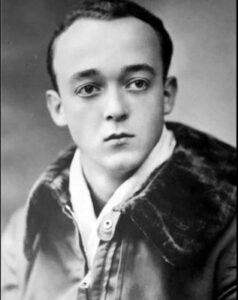
DOGFIGHT OVER BORDEAUX, FRANCE
On March 05, 1944, the 357th Fighter Group, led by Col. Russell Spicer, escorted B-24s of the Eighth Bomber Command on a raid to Bordeaux, France. The specific targets of the raid were submarines and their protection pens. The sub-pens were where the German “Wolf Packs” were based when not operating against Allied shipping.
I remember the weather conditions as being normal for Western Europe. Bombing would be guided by visual target selection, as lower clouds were scattered over the target area.
Upon rendezvous with the B-24 bombers, Col. Spicer (call sign “Dryden”) requested that the 363rd Squadron (“Cement” Squadron) furnish fighter support for a box of straggling B-24’s. My flight went back to pick up the stragglers.
I was leading the flight and my wingman was Lt. Bob Moore. The second element was led by Lt. William McGinley, with Flight Officer C.E. “Chuck” Yeager on his wing. Yeager was filling in for Lt. L.D. Wood on this particular flight. Wood had been forced to abort shortly after take off and returned to our base at Leiston, England, due to mechanical problems.
As we approached the stragglers, I’d searched the skies for enemy aircraft, but none were seen. We took up a flight position about 3:00 o’clock to the bombers, at their altitude (but out of range of their 50 cal. machine guns). This was where Bomber Command wanted the fighter escort to stay. While the bomber boys liked our position “nice and close”, it was all wrong for proper fighter coverage. We should have been about 5,000 ft. above and a couple of miles ahead of the bombers. At this time, General Jimmy Doolittle, was not commanding the Eighth, so we flew as ordered. Our primary mission was to protect the bombers not to destroy enemy aircraft. Wrong, but true.
We’d been with the stragglers less than a minute when I spotted an Me 109 attacking the bomber box from their 6:00 o’clock position. I’d just started to drop my left wing to attack the 109 when a call came from Yeager…”Break, Break”… we broke to the left. Yeager’s call saved us!
About 180 degrees through the break I latched on to a Fw 190 who was in a diving turn. I opened fire at a fairly close range, which resulted in some pieces coming off the 190. Both of us were now diving near vertical, when something large went flying past my cockpit.** I did not recognize what the object was at the time, however, I did see that I was fast approaching a solid undercast. It was time to start pulling up, as I had no idea how thick the cloud layer was and I figured the 190 was going straight down. I started to pull out and at this point, I did something really stupid; I let the P-51 go straight till it’s airspeed dropped well below 200 mph, when I broke into a left turn. And there was old Jerry, a Me 109 on my and Moore’s tail. After a tight circle, I couldn’t see him anymore and Moore and I headed back to England.
The longer we flew toward England, the worse the weather became. Moore and I could not communicate with each other because of radio failure. Ceiling and visibility were becoming more restrictive and luckily for us we made it into the RAF base at Ford, England.
As we spent the night at Ford, neither Moore nor I knew the group had lost both Russ Spicer and Chuck Yeager on the Bordeaux mission. I telephoned a claim for a “damaged” Fw 190 and our location. At first light we flew back to our base at Leiston. The next day, March 06, 1944, I got on the ground at Leiston just in time to Lead Cement Squadron on the first successful daylight bombing mission over Berlin, Germany.
Years later, at a 357th Fighter Group Association reunion, I told Chuck that I’d shot some pieces bigger that him off the enemy aircraft that shot him down. Yeager did know that a Fw 190 crashed near where he landed in his chute. I had often wondered why the Eighth Air Force had taken the unusual step to upgrade my “damaged” claim to the status of “probable destroyed.” At one of our reunions, I was kind of ribbing Yeager about being shot down by one of the greenest pilots in the German Luftwaffe. Little did I know how close I was to the truth.
Chuck had been after me for a long time to fly with him during one of our reunions. For personal reasons I had declined his invitations. However, on one occasion at a dinner party, he said, “OBee, I have a letter from a contact in France about that fight at Bordeaux. I’ll give you a copy after we make a flight together.”
I was delighted to fly with Chuck at our Louisville, Kentucky reunion. He had kindly given me a copy of the letter from Dr. Fuentes written in 1996 and mailed from France. The information showed that I had indeed shot down the Fw 190. While my official victory list maybe incorrect, I’m just happy to have made it into the Fighter Aces Association.
William R. “Obee” O’Brien
**Later learned, this German’s (22 year old Irmfred Klotz) parachute did not open. Letter from Dr. Fuentes in 1996
Obee O’Brien finished the war with 6 official victories. Chuck Yeager after parachuting into France, escaped into Spain and returned to the 357th to finish his combat tour. Chuck was credited with 11 ½ official victories and after the war became the first man to fly faster than the speed of sound in the X-1.

Unteroffizier Irmfried Klotz, of the 3./JGr. West, KIA 5 March 1944 in Fw 190A-4. Photo from Joey Maddox

